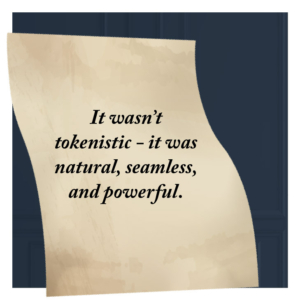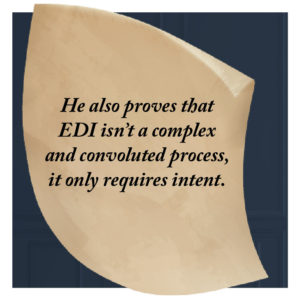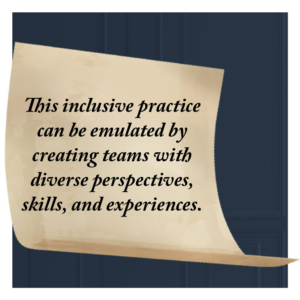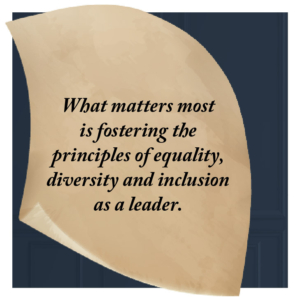As a British Asian and a child of immigrants growing up in the 90s and early 2000s, seeing yourself represented in your favourite TV shows or movies felt like winning the lottery. And finding your name on a keychain in a shop? Pure magic!
So, when I watched Armando Iannucci’s The Personal History of David Copperfield five years ago, something inside me lit up because of the bold, unashamedly diverse cast woven throughout the film.

What struck me was how Iannucci, as both writer and director, infused the film with such an effortless blend of people who are representative of diverse communities, mirroring the modern-day audience. It wasn’t tokenistic — it was natural, seamless, and powerful. Audiences everywhere loved it, with a Rotten Tomatoes score of 92%.
This wasn’t just a creative choice; it was effective leadership in action, and there’s a lot to learn from him when it comes to Equality, Diversity, and Inclusion (EDI) in leadership. As the driving force behind the project, Iannucci had the final say on most decisions. So, let’s dive into how his approach to filmmaking mirrors the kind of inclusive leadership that champions EDI values.
First, let’s understand the core values of EDI.
Equality, Diversity, and Inclusion policies aim to foster environments where all individuals, regardless of their background, have equal opportunities and feel valued.
These policies emphasise:
- Equality: Ensuring everyone is treated fairly and equitably, with access to the same opportunities.
- Diversity: Recognising and celebrating differences in race, gender, ethnicity, sexual orientation, disability, and other attributes.
- Inclusion: Creating an environment where diverse individuals are actively included, their voices heard, and their perspectives respected.
Here’s how EDI is embedded in Iannucci’s approach to the making of David Copperfield.

Promoting equality in leadership
He actively sought to hire individuals from diverse backgrounds, including different races, genders and sexual orientations. Dev Patel, a British actor of Indian descent, was cast as David Copperfield, the protagonist. In traditional period dramas, lead roles are usually played by white actors, reflecting historical British society. However, Iannucci deliberately chose a more inclusive approach, casting actors of various ethnicities in roles that had been historically portrayed by white actors. He also proves that EDI isn’t a complex and convoluted process, it only requires intent.
His diverse cast includes actors such as:
- Dev Patel: David Copperfield
- Nikki Amuka-Bird: Mrs. Steerforth
- Benedict Wong: Mr. Wickfield
- Divian Ladwa: Dr. Chillip
- Anthony Welsh: Ham
In fact, in Iannucci’s rendition, Copperfield’s mother is played by Morfydd Clark, a white, Swedish-born, Welsh actress who gives birth to David played by Dev Patel, an Asian actor.

By doing this, Iannucci disrupts the implicit bias that historical stories about white characters should be told only by white actors. This decision challenges traditional industry practices and promotes equality by giving opportunities to actors from underrepresented backgrounds. Iannucci said: “Well, why shouldn’t I choose from 100 per cent of the acting community?”
This inclusive practice can be emulated by creating teams with diverse perspectives, skills, and experiences. This in turn will encourage creativity by incorporating different viewpoints into decision-making. By recognising and celebrating diversity within a team through culture, events and discussions around different traditions, experiences, and identities we can encourage a more inclusive and equal workplace. To amplify this message even more, Iannucci said: “We are a multi-ethnic, diverse, generous, outgoing, humorous, creative country. I kind of wanted to celebrate that.”
Breaking conventional barriers
Iannucci’s decision to cast actors based on talent rather than appearance or adherence to period accuracy demonstrates a commitment to challenging conventional norms. This willingness to break barriers reflects strong EDI leadership. By doing so, he sends a message to the film industry that it is not only possible, but desirable, to move beyond traditional biases and represent a wider range of experiences and people.
Setting a standard for future productions
As both a writer and director, Iannucci held significant influence in shaping the film’s vision. His decision to implement EDI in such a high-profile production sets a precedent for other filmmakers and studios. It reflects a broader industry movement toward diversity in storytelling, and Iannucci’s leadership here can inspire others to adopt similar inclusive practices.

In this sense, he is not only practicing EDI in his work but also influencing broader industry trends.
Iannucci’s leadership is evident in the way he challenges industry norms, advocates for representation, and sets a standard for inclusive filmmaking. By doing so, he aligns with and exemplifies EDI principles, making him a powerful leader in fostering equality, diversity, and inclusion in the arts.
Iannucci said: “The story is the least interesting part”. What matters most is fostering the principles of equality, diversity and inclusion as a leader, in all walks of life.
















